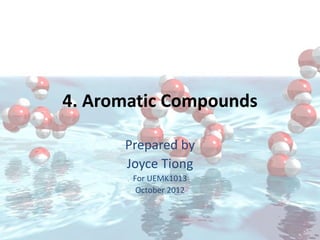
4. aromatic compounds-students_copy
- 1. 4. Aromatic Compounds Prepared by Joyce Tiong For UEMK1013 October 2012
- 2. Benzene • 1825, Michael Faraday found a compound with C:H ratio of 1:1. • 1834, Eilhard Mitscherlich produced the same compound and found the molecular formula of C6H6. • It was then named benzene. • Other compounds with low C:H ratios were then classified as aromatic compounds. 2
- 3. Benzene • Benzene occurs in two Kekulé structures. Kekulé structures: resonance structure of the benzene ring with alternate double and single bonds 3
- 4. Properties of Benzene • Benzene ring is planar. • All C-C bond lengths are the same (1.397 Å) and all bond angles are 120o. • Delocalisation of the electrons gives benzene great stability. 4
- 5. Reactions of Benzene • Reacts with Br2 in the presence of FeCl3 catalyst to form bromobenzene + HBr 5
- 6. Annulenes • Annulenes: cyclic hydrocarbons with alternating single and double bonds. • Eg.: Benzene = 6-annulene. • Criteria for annulenes: MUST have – Cycle with conjugated double bonds – Planar to allow overlapping of π-orbitals 6
- 7. Exceptions of Aromatic Compounds • Cyclobutadiene and Cyclooctatetraene are NOT aromatic compounds because they don’t form Kekulé structures. • Cyclobutadiene (C4H4) is very reactive, it dimerizes (forms C8H8) very quickly. • Cyclooctatetraene adds Br2 readily. 7
- 8. Hückel’s Rule • For a cyclic compound with alternating double and single bonds, if: – (4N+2) = aromatic – (4N) = antiaromatic – N = 0, 1, 2, … – Example: • Benzene (C6H6): • 6 = 4N+2, N = 1 • ∴ aromatic • Cyclobutadiene (C4H4): • 4 = 4N, N = • ∴ anti-aromatic 8
- 9. Aromatic, anti-aromatic, non- anti- non- aromatic Cyclic Planar Every C-atom Fulfill with π orbital Hückel’s Rule Aromatic Yes Yes Yes 4N+2 Anti-aromatic Yes Yes Yes 4N Non-aromatic No Maybe No No 9
- 10. Reactions of Aromatic Compounds • Halogenation of Benzene • I) Bromination – Br2 donates a pair of electron to a strong Lewis acid catalyst, FeBr3 to form a stronger electrophile. 10
- 11. Bromination of Benzene – Benzene attacts to form sigma complex. – Bromine ion from FeBr4- acts as a weak base to remove a proton to form bromobenzene and HBr. 11
- 12. Chlorination of Benzene • Chlorination is similar to bromination. • AlCl3 is used as a Lewis acid catalyst together with Cl2 to form chlorobenzene. 12
- 13. Iodination of Benzene • Nitric acid (HNO3) oxidizes iodine to an iodonium ion. 13
- 14. Nitration of Benzene • Use sulfuric acid (H2SO4) with nitric acid (HNO3) to form nitronium ion electrophile. • Sulfuric acid acts as a catalyst. 14
- 15. Other reactions… • Sulfonation • Desulfonation 15
- 16. Other reactions… • Nitration of Toluene • Bromination of aniline 16
- 17. Summary of activators • Functional group reactivity Increasing Reactivity 17
- 18. Nitration of Nitrobenzene • Nitrobenzene is 100,000 less reactive than benzene. • Nitration is performed in concentrated HNO3 and H2SO4 >100oC. • Forms majority meta- isomers. 18
- 19. Friedel- Friedel-Crafts Alkylation • Synthesis of alkylbenzenes from alkyl halides and a Lewis acid (usually AlCl3 or FeCl3). 19
- 20. Friedel- Friedel-Crafts Acylation • Acyl chloride (RCO-Cl) reacts with benzene to form phenyl ketone (an acylbenzene). • Reaction is analogous to alkylation, but the final product is a phenyl ketone. 20
- 21. Example of Friedel-Crafts Acylation Friedel- 21
- 22. Other Reactions… (I) • Clemmensen Reduction acylbenzene alkylbenzene upon treatment with HCl and amalgamated zinc Amalgamated: to mix a metal with mercury. 22
- 23. Other Reactions… (II) • Chlorination of Benzene – Occurs with high heat and pressure (or light) – Results in benzene hexachloride, used as an insecticide. Benzene Benzene hexachloride 23
- 24. Other Reactions… (III) • Catalytic Hydrogenation of benzene – With catalysts: Pt, Pd, Ni, Ru or Rh 24
- 25. Side Chain Oxidation (I) • Alkylbenzenes can be oxidized to benzoic acid by hot KMnO4 or Na2Cr2O7 in H2SO4. • Produces carboxylate salt of benzoic acid. 25
- 26. Side Chain Halogenation (I) • Occurs in the presence of benzylic position. 26
- 27. Side Chain Halogenation (II) • Chlorination • Bromination 27
